Contact centers (sometimes referred to as call centers) are a key element in a seamless customer journey, and in business success.
In the hybrid workplace, with remote call centers being the norm for many businesses, today's contact center technology has become more powerful and complex, as it deals with multiple channels, touchpoints and enterprise systems.
Contact center analytics software helps businesses to deliver a seamless omni-channel customer journey, using Interactive Voice Response (IVR), speech analytics and interaction analytics, combined with historical data and other channels.
Constantly monitoring and tracking customer interactions allows organizations to predict future customer behavior as well as ensuring a positive customer journey.
In this guide we'll share comprehensive insights into how organizations can improve customer experiences as well as call center performance through contact center analytics.
Find our more about the real value of customer experience
Download our guide today.
The need to know
The COVID-19 pandemic dramatically altered how consumers buy, and how businesses are expected to accommodate and respond to customer needs more quickly and efficiently than ever before. This has highlighted the importance of analyzing data, as data driven insights are the key to knowing how customer issues are impacting your business.
Contact center analytics are one of the most important elements in enhancing customer interactions, call center performance and increasing business intelligence for the benefit of business operations.
Today's consumers have grown accustomed to new ways of interacting with brands. With a pronounced pivot towards digital sales, remote workforces, and across-the-board increases in call volumes, customer service teams are now serving customers in more complex, holistic ways than ever.
There is no doubt that your call center is one of the most data-driven area of business, and so an organization's call center performance metrics inform everything from long-term planning to real-time response, as well as creating insights that lead to better call center efficiency. 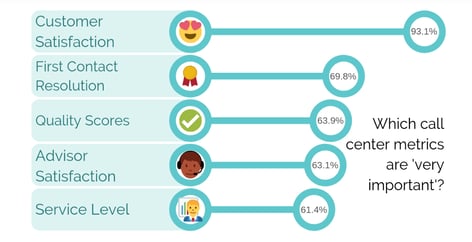
Image source: Babelforce
Call center analytics explained
Call center analytics provide valuable insights for customer service teams aiming to make significant customer service improvements.
The process of collecting contact center data analytics and studying customer data enables businesses put their customers first. The value of call data is that it enables a call center team to provide a highly personalized customer interaction while elevating their own growth benchmarks.
Call center analytics provide data driven insights, not just about your customers' satisfaction levels, but also about an agent's performance, call volume, frequency trends, and product performance.
"The global contact center analytics market size was valued at USD 1.22 billion in 2021 and is expected to expand at a compound annual growth rate (CAGR) of 19.3% from 2022 to 2030."
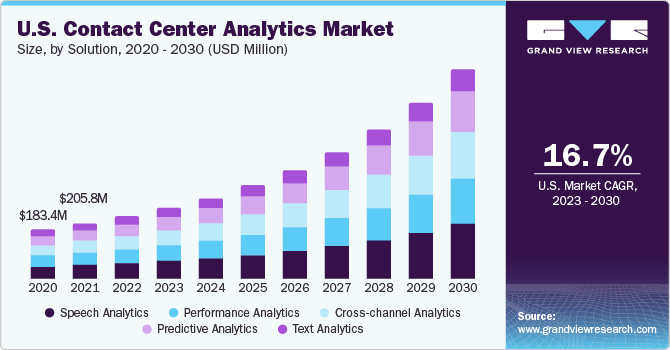
U.S. contact center analytics market size, by solution, 2020 - 2030 (USD Million)
Image source: Grandview Research
What are call center analytics used for?
The key purpose of call center analytics is to collect, measure and analyze customer data within a contact center to reveal valuable insights using key performance metrics, and turning these into actionable insights.
This includes call data and agent performance, as well as Customer Satisfaction (CSAT), handle time, and service-level agreement (SLA) performance.
Analytics can be historical or predictive. Both predictive analytics and historical analytics help to examine multiple customer-related data sources. Capturing data through customer satisfaction surveys, customer feedback, call recordings, behavior data, customer conversations etc. can identify customer trends, as well as interaction opportunities, to serve as a source for modeling.
Benefits of Call Center Analytics
Analyzing call center data not only helps businesses understand customer sentiment, and what is currently happening with their contact center operations but also what they can expect in the future.
Some of the benefits benefits include:
- Reducing costs by decreasing call handling times as well as call volume
- Creating actionable insights to help improve future interactions with customers
- Helping agents improve performance by analyzing their own customer interaction data
- The utilization of AI and ML tools to analyze voice and speech. This helps develop personalized training programs
- Developing optimized workflows based on customer behavior patterns
- Identifying issues that can be solved by interactive voice response (IVR) or self-serve portal
Different types of call center analytics software and how they're used
Call center analytics have the power to provide real time and historical information for analysis. This includes call recordings, how tickets are handled, customer experience surveys, voice and speech quality, call volume data and net promoter score (NPS).
The type of data you want to collect depends on the key call center performance metrics you want to monitor and analyze, such as call handling time, customer satisfaction score, agent turnover and ticket resolution rates.
In the past, call center data for these key metrics was usually collected manually, by recording calls to analyze an agent's performance and create specific training programs.
Modern call center analytics use AI and machine learning tools, and analytics can be viewed through a call center analytics dashboard. This not only saves time, but increases data accuracy.
Here are some of the different types of call center analytics that can not only boost contact center performance, but enhance the experience and satisfaction of both your customers and call center agents.
Predictive analytics
Predictive analytics uses both current and historical data to provide call center operations with insights on what may happen in the future. For example, predictive data analytics can help call center managers determine the number of people required to handle high call volumes during the holiday season.
Call center predictive analytics can also track and record how a new product rollout affects call volume and demand. This type of call center analytics is extremely useful in forecasting future trends by using cutting-edge technologies.
Predictive analytics utilizes Artificial Intelligence (AI) and machine learning, sentiment and speech analysis, text analytics (used when interacting through chat, email or chatbots), big data analytics and more.
With predictive analytics, call center operations can analyze outbound an inbound calls to better plan for the future by looking at past results and the intervention measures used to solve issues.
Call Center Desktop Analytics
Call center desktop analytics are extremely useful in utilizing real-time call monitoring to record inefficiencies, improve security, and provide valuable feedback opportunities for agent performance. Desktop analytics can measure the efficiency of contact center agents as well as the systems, by monitoring customer interactions in real time.
Call center desktop analytics can improve the optimization of both customer and agent experience. Repetitive, simple tasks can be monitored and assigned to automation, freeing up the employees’ time for more important, cognitive tasks.
Speech and voice analytics
Speech analytics:
Recording customer calls is the primary data source for call center speech analytics.
The data harvested from speech analytics, phone calls and interactions with customers focuses on identifying some of the common problems customers are experiencing through the tone and intonation of the customer’s voice.
In this way, the software can recognize and automatically tag emotions. Using artificial intelligence and machine learning techniques, speech analytics can isolate key phrases and words in a conversation, helping gain customers' experience insights and understand customer sentiment trends.
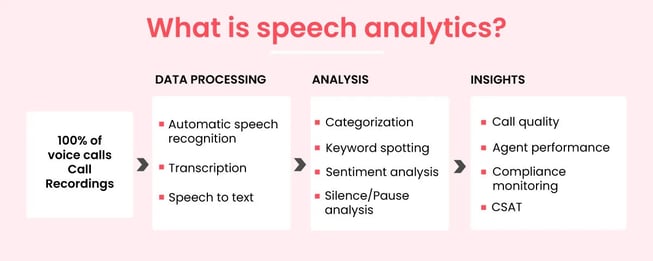
Image source: Call Hippo
Voice analytics:
This technology has become more sophisticated, and can now analyze customer calls for parameters, such as tone, pitch, stress and rhythm, of both the caller and the agent.
This gives contact center managers the tools to monitor in real time if a call is progressing in a negative way, and intervene if necessary to help the call agent resolve the issue. Voice analytics can also help to create personalized training programs for agents based on this data. 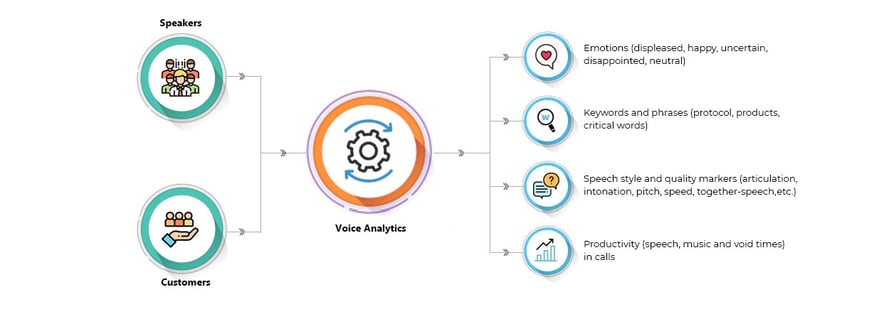
Image source: Beyond voice
Interaction analytics
Every interaction with a customer creates an opportunity to understand them better. This is an invaluable way to use call center data to not only expand a customer base but also understand how to reach out to customers.
Interaction analytics also offers insights into customer behavior, their specific likes and dislikes, and brand expectations to help businesses identify trends and uncover additional marketing opportunities.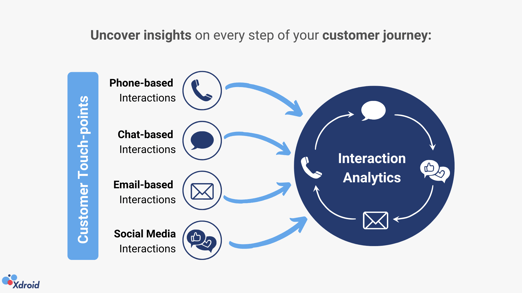
Image source: XDroid
Customer Satisfaction analytics
Most call centers send out customer surveys immediately after a call has ended, with the aim of gathering valuable information about customer satisfaction levels.
An expertly designed customer satisfaction survey can be used to gain further insights into product performance, agent performance and a customer's overall experience. Customer survey responses are not always guaranteed, however, so this type of analytics can be difficult to measure.
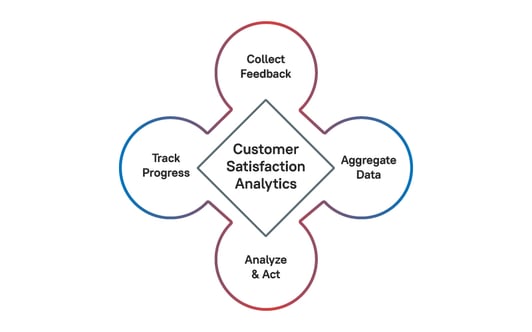 Image source: Insight 360
Image source: Insight 360
Self service analytics
While some customers, particularly from older demographics, are at first resistant to self-service, they quickly realize its benefits. Many tech-savvy businesses are optimizing specific tasks with self-service channels.
An example of a self service option is instead of a customer calling to update their address or to check the status of an order, they can do so online.
Self-service data analytics can reduce the chance for human error as well as the volume of incoming calls received by a contact center. Using self service channels translates to a drop in overhead costs, more engaged contact call center agents, and satisfied customers.
Self-service analytics, including the use of chatbots, requires little human interference once it’s set up within an organization's technological infrastructure.
Omnichannel analytics
Customers who interact with your contact center may already have had an experience with the brand via other channels, like social media, email or a self-service portal.
Omnichannel analytics data helps agents provide a highly customized experience to the callers, improving call handling times as well as customer satisfaction levels.
Collecting customer data can help determine where and why things may be going wrong and prevent problems before they start. For example, if many customers reach out about order-processing time, you can collaborate with operations and maintenance to make improvements.
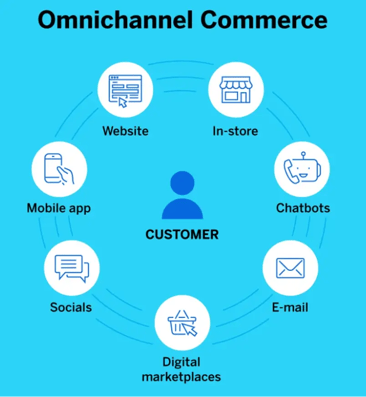
Image source: Qualtrics
Text Analytics
This type of call center analytics mainly involves focusing on written communication, including web chats, emails, documents, and social media comments.
In the past few years, the use of social media has exploded, and text analytics of social media comments have come to be exceptionally informative. With so many brands online, social media has become one of the primary forms of communication.
Call center text analytics tools monitor and assign specific values to words and phrases. Data mining functions can then identify patterns and relationships in the sets of data.
Text analytics data can make conclusions about the messages being sent by an organization and its customers, pointing out any issues from the customer’s mindset.
Customer Retention
Customer retention rate is the percentage of existing customers who remain customers after a given period.
Your customer retention rate can help you better understand customer engagement, what affects customer relationships with your company, and can also signal opportunities to improve customer service.
A packet loss test tool allows you to quantify packet loss performance, and confirm the reasons behind it, for example if the issue is due to the network connectivity or the quality of the network degrades due to TCP or UDP packet loss.
Once you understand how well or poorly your company retains customers, you can use data analytics to improve your customer retention rate.
Analytics can help calculate customer retention rate from the first interaction. A customer may “like” your Facebook page or subscribe to your email list. The three key customer retention data points are:
- Customers at the start of a given period
- Customers at the end of that period
- New customers acquired during that period
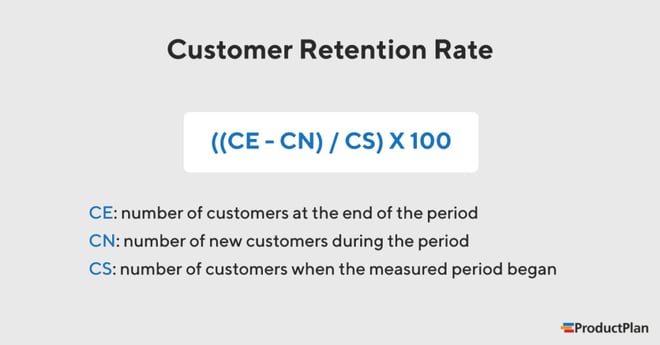
Image source: Product Plan
Customer effort score
A customer effort score is a quantifiable measurement of the amount of work a customer puts in to get information they need or to reach a resolution on an issue.
Harvard Business Review introduced the idea of customer effort back in 2010 as something that is directly tied to customer loyalty, and to help measure customer satisfaction.
Service professionals are now prioritizing this Key Performance Indicator (KPI) with the same importance as tried-and-true metrics like customer satisfaction, revenue, and customer retention, according to the latest findings from the Salesforce State of Service report.
Contact center analytics, in particular, cross channel analytics, examines multiple customer-related data sources to identify customer trends, as well as interaction opportunities, to serve as a source for modeling. Customer analytics can be historical or predictive.
Data sources include voice of the customer, behavior data, demographics, and purchase data..png?width=622&height=454&name=7e655854-2257-4130-9ba0-602b788df170%20(1).png)
Image source: ProProfs
Customer effort score
Contact center software and analytics has fundamentally changed the role of contact centers from a basic service offering to a strategic differentiator, that can make dramatic improvements in customer experience and financial performance.
According to McKinsey, a call center operation that applies analytics can reduce average customer handling time by up to 40%.
Additionally, analytics can help increase self-service containment rates by 5 to 20%, cut employee costs by up to $5 million, and boost the conversion rate on service-to-sales calls by nearly 50%- with the added bonus of improving customer experience and employee engagement.
While analytics is only one of a broader set of improvements, including operational changes such as coaching and process simplification, it is a powerful tool to enhance business intelligence.
Measuring call center agent performance
A call center agents performance can be the most significant driver for customer relationship management, and a satisfying customer journey, but it can also be the biggest deterrent. So it’s vital to utilize contact center analytics to monitor agent performance in real-time.
Data driven advanced performance analytics software takes many of the variables out of creating the best customer/agent relationship experience. By using a combination of the above types of analytics, businesses can determine which languages and behaviors are helping contact center agents reach their target goals and key performance indicators (KPIs).
This in turn helps businesses reduce Average Handle Time (AHT), increase first call resolution and reduce costs of operating call centers. First Call Resolution (FCR) is an important factor for any company, in retaining the loyalty of your customers, and measuring agent productivity.
Quantifying customer loyalty
Repeat purchases say a lot about customer experience and satisfaction. An item purchased repeatedly means they are likely happy with the product. This leads to a higher customer lifetime value and the likelihood they will recommend the brand to their network and contacts.
Analytics software can track repeat frequency, customer lifetime value, and average cost per order. These are all metrics that indicate customer satisfaction, and help to make decisions about your business.
For example, if a specific product is sold in larger numbers to repeat customers rather than to new ones, you may see a higher level of satisfaction long-term with that product over one that is popular only with new customers. Based on these insights, you might rethink your product strategy.
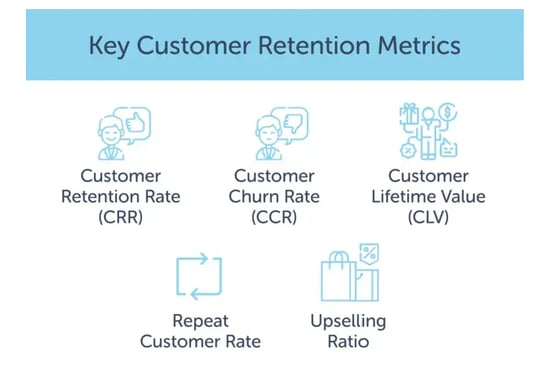
Image source: Nexcess
The cloud and call center data and analytics
Many businesses are still grappling with legacy on-premise software that offers little or no scalability, AI functionality or remote working capability that most of today's organizations need. Partially or fully moving to the cloud is therefore becoming a priority.
As businesses adopt cloud contact centers with AI capabilities, they position themselves to take advantage of an unprecedented depth of customer intelligence through contact center analytics. This has the potential to enable organizations to properly analyze data and significantly improve on customer experience in today’s environment.
Delivering better customer intelligence
With rich repositories of insights on what customers want and don’t want, as well as reams of product and services feedback, your marketing team will be better equipped with the tools to gain new customers, and your contact center can improve their customer experience strategy.
Call center analytics software
There are various different types of software for call centers, such as Zendesk, Freshdesk, Aircall and Salesforce, that can provide the analytics you need to service your call center. Forbes Advisor evaluated them to come up with this list of best call center software 2024.
The right tools for contact center analytics
As we've discussed, today's contact center utilizes a mixture of technologies to address different channels of communications. In an increasingly digital and automated world, contact centers are one of the few opportunities for human interactions your customers will have with your brand.
This means call center agents are often faced with a complex environment, so high uptime and fast problem resolution have never been more vital.
The best way to cut through the complexity of today's busy contact center environment is with third-party monitoring and performance management tools like IR Collaborate.
Designed specifically for contact center performance, you can that voice quality, connection with customers, availability, and critical systems are problem-free so you can deliver a superior experience.
Monitoring, troubleshooting and resolving contact center issues in real time
Performance management tools need to be able to see across all domains in order to have full visibility.
Today, a call center might utilize dozens of pieces of technology. To have a monitoring tool for each application is adding unnecessary and unmanageable complexity to the call center infrastructure, and added burden for call center managers.
Find out how monitoring contact center technology can solve common issues
Read our comprehensive guide.
With IR’s Collaborate suite of solutions you can get vital end-to-end visibility of your entire contact center environment from a single pane of glass. This enables organizations to easily channel analytics, but most importantly to turn those cross channel analytics into actionable insights, to improve call center productivity, and business outcomes.
How IR Collaborate can help
IR Collaborate captures data and provides visibility across all vendors, applications and hardware devices.
The ideal analytics solution should begin with everything on one dashboard which you can click through wherever you need, until you arrive at the root of the problem. With IR Collaborate, you can:
Monitor, troubleshoot and resolve issues in real-time
Time is money when contact center problems are impacting your customers' experience. IR Collaborate can help you fix problems fast to minimize the impact on productivity, revenue and your customers' experience.
One dashboard for complete visibility
Broad multi-vendor, multi-technology coverage means you can streamline IT processes and operations with visibility across all your contact center software from a single visibility vantage point.
Avoid downtime and boost customer satisfaction
IR Collaborate can help you to maximize system performance, optimizing productivity and helping you avoid costly outages to streamline the experience for your customers, and protect your reputation.
Leverage new technology and improve experience
Changing your organization’s infrastructure can impact end user experience. IR Collaborate can help make sure that impact is a positive one and give your new technology deployments the best chance of success.
Independent research firm Nemertes Research found that organizations using third party solutions for monitoring and troubleshooting their contact center operations enjoy a host of benefits in comparison to those who don't - including potentially halving UCC operational costs!
Not only does analytics software like IR Collaborate gather important data, but with it will proactively monitor contact center systems in real time, providing optimum business intelligence, and helping to prevent potentially disastrous downtime.



